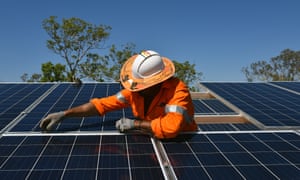Solar farm approvals and record rooftop installations expected to ‘turbo-boost’ production
A record-breaking month of rooftop installations and a flood of large-scale solar farms could almost double Australia’s solar power capacity in a single year, industry analysts say.
A massive solar energy boom is being predicted for 2018, after an unprecedented number of industrial solar farms were approved by the New South Wales and Queensland governments last year.
Last month also became the biggest January on record for rooftop installations, according to the renewables website RenewEconomy and industry analysts SunWiz.
With 111MW of new panels, it saw a 69% rise compared with the same month last year and became one of the top five months ever – largely driven by low installation costs and a boost in commercial uptake.
At the same time, nearly 30 new industrial solar farms are scheduled to come on line.
The new farms could be operational within the year, according to John Grimes, the chief executive of the Clean Energy Council.
“These solar farms can be built within a matter of weeks,” he said. “They’re really quick and simple.”
Together, the new large-scale projects could add between 2.5GW and 3.5GW to the national grid and rooftop installations could add another 1.3GW, according to the Smart Energy Council’s estimates. This would nearly double the nation’s solar energy capacity, currently 7GW, in a single year.
“The train tracks are about to converge,” Grimes said. “Rooftop installations and utilities are both booming and could turbo-boost the solar numbers overall.”
In Queensland, residential solar panels are already the state’s largest source of energy, producing more combined than the 1.7GW Gladstone power station. Just under a third (30%) of residential homes in the state have solar installed – the most in the country.
With the completion of the new solar farms, solar will provide 17% of the state’s energy. “We’ve turned the sunshine state into the solar state,” Queensland’s former energy minister Mark Bailey said in October.
In New South Wales, the planning minister, Anthony Roberts, said the 10 new solar farms would generate 1.2GW of energy and reduce carbon emissions by more than 2.5m tonnes – the equivalent of taking about 800,000 cars off the road.
In January this year, NSW announced another plant – the 170MW Finley plant in the Riverina – as did Queensland, the 120MW solar farm at Munna Creek.
Grimes said the solar boom “was only going to grow” in future.
“Solar is the cheapest way to generate electricity in the world – full stop,” he said. “It’s not unusual for grid pricing to be north of 20c per kilowatt hour in a majority of jurisdicitions. A solar array, at an average size for an average home, if you amortise the cost over 20 years, the effective rate is 5c per kilowatt hour. That’s called an economic no-brainer.”
He said the rush to install rooftop panels could have been sparked by January’s warm weather and rising energy prices.
“I think people are acutely aware of energy prices. People are running air conditioning and thinking, ‘hooley dooley I’m going to get a bill’.”
2017 saw a record 1.25GW of solar power added to the grid nationally, counting both large-scale solar farms and rooftop panels. The predicted rate of rooftop panels alone in 2018 is expected to be 1.3GW.

No comments:
Post a Comment